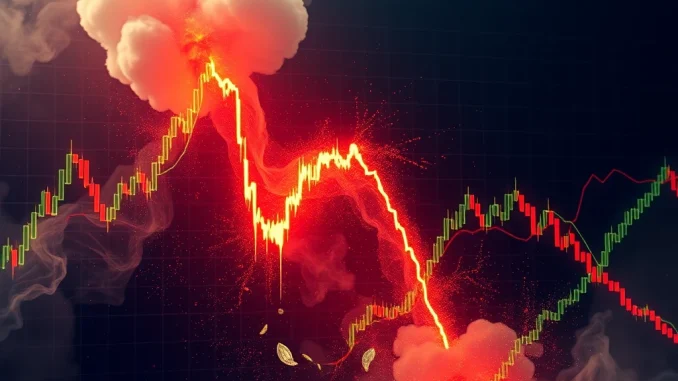
The world of digital assets is no stranger to volatility, but recent events have underscored just how quickly fortunes can change. We’ve just witnessed a significant shake-up in the market, marked by substantial crypto liquidations. This isn’t just a minor blip; it’s a powerful reminder of the inherent risks in leveraged positions within the digital asset space.
What Exactly is Futures Liquidation?
At its core, futures liquidation occurs when a trader’s leveraged position is automatically closed by an exchange due to a failure to meet margin requirements. Think of it like this:
- You borrow funds (leverage) to open a larger trade position than your initial capital allows.
- The market moves against your position.
- Your losses erode your margin (the collateral you put up).
- If your margin falls below a certain threshold, the exchange forces the closure of your position to prevent further losses, often at a significant loss to the trader.
This process is automated and happens rapidly, especially during periods of high volatility.
Why Did We See Such Massive Crypto Liquidations?
The recent surge in crypto liquidations is directly tied to price movements in the underlying assets, primarily Bitcoin and Ethereum, but also impacting the broader cryptocurrency market. When prices experience sharp, sudden swings – either up or down – traders with highly leveraged positions are vulnerable.
In the past hour alone, major exchanges saw approximately $152 million worth of futures positions wiped out. Expanding the view, the past 24 hours tell an even more dramatic story, with over $1.123 billion in futures liquidated across the market. This indicates a significant price move that caught many traders off guard, forcing their leveraged bets to be closed out.
Impact on the Cryptocurrency Market
Large-scale liquidations can have a cascading effect on the cryptocurrency market. As positions are force-closed, the selling (or buying, in the case of short liquidations) pressure can exacerbate the initial price movement. This can lead to further liquidations, creating a cycle that intensifies volatility.
While painful for individual traders, these events are a natural, albeit dramatic, part of how leveraged markets function. They help reset market imbalances and can sometimes precede periods of consolidation or trend changes.
Navigating Volatile Crypto Trading Conditions
For those engaged in crypto trading, especially with leverage, events like these highlight the critical importance of risk management. Here are a few actionable insights:
- Understand Leverage: Know exactly how much leverage you are using and the liquidation price for your position. Higher leverage means greater risk of liquidation.
- Use Stop-Loss Orders: These orders automatically close your position if the price reaches a certain level, limiting potential losses before liquidation occurs.
- Maintain Sufficient Margin: Avoid using maximum leverage. Keep extra collateral in your account to withstand adverse price movements.
- Stay Informed: Keep track of market news and potential catalysts for volatility.
- Consider Lower Leverage or Spot Trading: If you are uncomfortable with the risks of liquidation, consider reducing leverage or trading without it entirely on the spot market.
Understanding Bitcoin Liquidation and Altcoins
Often, a significant portion of these large liquidation events involves Bitcoin liquidation. As the largest and most influential cryptocurrency, Bitcoin’s price movements tend to have the biggest impact on the derivatives market. However, Ethereum and various altcoins also contribute significantly to the total liquidation figures, especially during periods when altcoins experience even higher volatility than Bitcoin.
Analyzing liquidation data, particularly the breakdown between long (bets on price increase) and short (bets on price decrease) liquidations, can offer insights into market sentiment and potential future price direction. A large wave of long liquidations suggests a sharp price drop, while short liquidations point to a rapid price increase.
Conclusion: A Stark Reminder of Market Risks
The recent $1.1 billion wave of crypto liquidations serves as a stark reminder of the risks inherent in leveraged crypto trading within the volatile cryptocurrency market. While futures liquidation is a mechanism designed to manage risk for exchanges, it can be devastating for traders caught on the wrong side of a sudden price swing. Understanding what causes these events, implementing robust risk management strategies, and being aware of the potential for large-scale Bitcoin liquidation and altcoin liquidations are crucial for anyone participating in this high-stakes environment.
Stay safe out there, and trade wisely.



